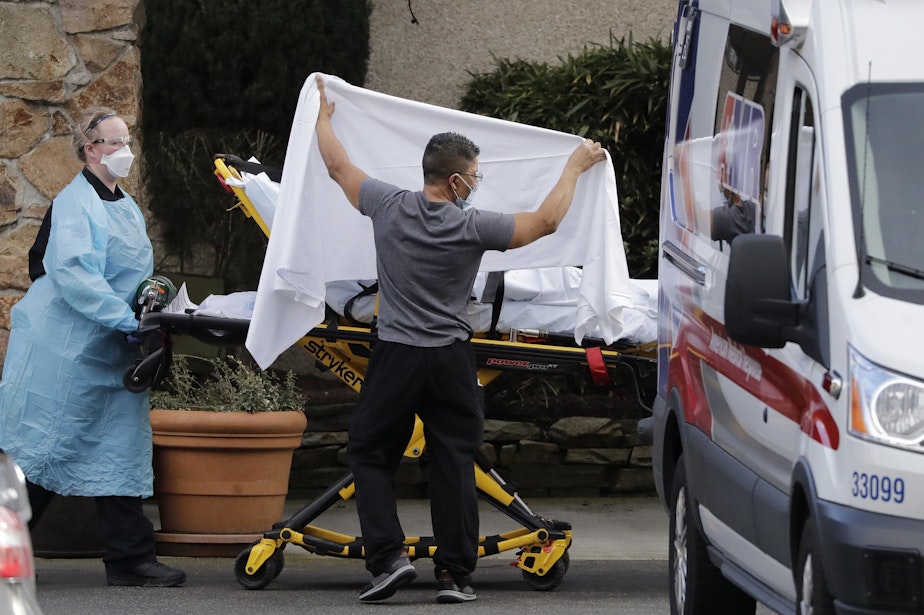What's with this protective medical gear? Readers wrote in, concerned

Readers wrote in this weekend, concerned with the photo above. It shows emergency responders transporting a patient, someone possibly infected with coronavirus, from the Life Care Center in Kirkland, the epicenter of the nation’s first coronavirus deaths.
The responders are dressed in gowns, gloves and masks. There is also a man holding up a sheet to guard the patient's privacy, although he wears a T-shirt, and no gloves.
Readers compared this lighter look with the more hazmat-and-goggles look out of China and parts of Europe during this coronavirus outbreak.
Dr. Clyde Crumpacker, infectious disease specialist and professor at Harvard Medical School, said gowns, goggles and gloves were essential when dealing with coronavirus patients. The Centers for Disease Control and Prevention makes the same recommendation.
Crumpacker's concerns weren't with what the responders wore in this photo, but with the United States' “slow response” to the coronavirus outbreak. Crumpacker said 1,700 healthcare workers in China have been infected, and some have died.
“Initially when this occurred, [Chinese healthcare workers] weren’t protecting themselves either,” Crumpacker said. “The danger to ... healthcare workers and first responders is a real one. I think the U.S. is just catching on now, late.”
On Monday, King County health officials announced the coronavirus death toll had reached six in Washington state, all in the Seattle area, and that there are 18 confirmed coronavirus cases overall in Washington. Officials said the virus is just taking off.
Meanwhile, first responders in the Seattle area told KUOW that they are following the protocols set by the Centers for Disease Control and Prevention and Public Health -- even if they don't look like they stepped off the set of Outbreak.
Readers weren't convinced when they saw the photograph that we published above.
Sponsored
Kirkland and Redmond emergency departments have made some adjustments to precautions that responders take — insisting, however, that they have always been careful.
In Kirkland, emergency responders have always used personal protection equipment (mask, eye protection, gown and gloves) when responding to individuals with flu symptoms or respiratory illness, said Kellie Stickney, spokesperson for City of Kirkland.
As of Friday afternoon, Kirkland first responders are now wearing this safety gear every time they respond to the Life Care Center, Stickney said.
After every coronavirus call, responders decontaminate their rig, clean the gurneys, and wipe down the entire inside of their rig, she said. Responders also take themselves out of service for a period of time, to wash their clothes and take a shower.
Sponsored
The photos of first responders and nursing care workers in Kirkland show that some of the CDC recommendations are followed, although not all.
In one image, a first responder wipes down the rig wearing gloves – but just a T-shirt, leaving arms exposed.
In another photo, the glove is not fitted around the cuff of the gown, as the CDC recommends. The gown sleeve falls over the glove.
Sponsored
Earlier, while at the senior living facility, family members, and other visitors, entered and exited the Life Care Center, including a woman who stopped by to pay a visit to her mother who was recovering from a broken hip.
A KUOW reporter witnessed a patient being transported into the ambulance without a safety mask — which the CDC says is crucial when dealing with coronaviruses. Although it was not clear if this patient was suspected of having coronavirus, the patient was coming from a the quarantined center of the outbreak in the U.S.
According to the Guideline for Isolation Precautions: Preventing Transmission of Infectious Agents in Healthcare Settings, isolation gowns are used to protect responders' arms and exposed body areas "and prevent contamination of clothing with blood, body fluids, and other potentially infectious material." The report was last updated in July 2019.
The guidelines also state "full coverage of the arms and body front, from neck to the mid-thigh or below will ensure that clothing and exposed upper body areas are protected" and that "masks are placed on coughing patients to limit potential dissemination of infectious respiratory secretions from the patient to others."
Sponsored
Public Health Seattle & King County did not respond to a request for comment, nor did the CDC, by publication time.
In Redmond, Fire Chief Tommy Smith said it's basically business as usual, although now they must wear disposable gowns. Responders have always worn goggles, masks and gloves when the potential of catching the flu loomed, he said.
Similar to Kirkland, Redmond first responders decontaminate their emergency vehicles before returning back to service. Sanitizing happens at fire stations too, since they house firefighters responding to potential coronavirus patients.
“Each and every day (firefighters) show up to work and respond to these calls knowing the risk is out there that they can't see,” Smith said. “As an organization, we’re doing everything we can to make sure they’re protected.”
KUOW's Megan Farmer contributed to this report.

